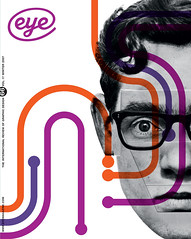Winter 2007
Printing.com
Where digital tools changed design, global communications and green issues are redefining the world of print
Three little acronyms dominate the way that designers and printers now work together: PDF (portable document format), FTP (file transfer protocol) and CTP (computer to plate). As colour reproduction became digitally based, the specialised craft skills of the repro house largely disappeared. The film-to-plate process was replaced by sending pages as PDF files, whose automated production from Quark and InDesign embeds text and pictures in a format that can be distributed, viewed and used in high-resolution printing. The use of FTP sites means that large files can be transferred anywhere in the world that has good internet access. And with CTP systems, the printer can simply take the PDF files and impose them from his computer direct to the printing plate.
The way a job gets to press has been radically streamlined: more direct work by the designer (all those text corrections and Photoshop retouching), with the files arriving in a ready-for-press format at the printer. If you can wait for the printed copies you can send a job to China (look at the imprint on most colour books), or if you need it in your hands tomorrow, print it locally: either route uses the same tools and workflow.
Even the high street printer, traditionally seen as struggling with a small press in the back room, is changing: the simplicity of working with PDF files means that companies such as Printing.com can feed work from their franchisees – small shops or design studios anywhere in the world – to a central printing hub where economies of scale are possible through standardised formats and materials, grouping of individual jobs and large presses. The finished printed jobs can then be despatched by one of the many courier systems that have grown up in the new age of Web shopping.
But now digital printing, whose technological origins lie more in the office Xerox machine, offers an alternative way of putting ink on paper. Instead of a fixed printing plate being used to make multiple copies, digital printing can re-image each time you output a printed item. Now, a new range of options exist for a piece of print: the cheaper set-up costs mean that short print runs, even single copies, are economic, or that the text and images can be different for each copy.
‘It’s a huge area of innovation’ says Richard Owers of Beacon Press, a printer that offers both processes. ‘Where once we saw runs of 100,000 copies printed conventionally, now we might see a 10,000 digital run where each copy is different and personally targeted. This is a big change in thinking for marketing departments.’
Digital printing has also opened up limited-edition and self-publishing for jobs such as reprints and monographs. Websites like Blurb enable you upload files and receive back printed, case-bound books.
Colour printing is quicker and cheaper than ever before. But what about the quality of the work? In some respects the average quality of a piece of print is better than before but, as Owers points out, the dominant aesthetic is now one of ‘good enough colour’. The near-universal use of digital images and the automation of RGB to CMYK colour conversion in the PDF process has created a ‘dumbed-down’ standard of expectation when a much higher level is entirely possible. ‘We still have a digital repro department,’ says Owers, ‘and we can use all the new technology to do high-end colour. Adjusting the colour conversions for supplied images and profiling for presses and papers can create a bespoke piece of print. We also print alcohol-free, which is environmentally better, has cut our water consumption and, we think, gives more vivid colour.’
At the moment the greatest challenge for print comes in facing up to the environmental demands from designers, consumers and boardrooms, whether driven by profit, legislation or conscience. In the future we will see more development in the way printing technology can help the industry print fewer copies using sustainable materials, while causing less waste and creating the smallest possible carbon footprint in the process.
Simon Esterson, art director, Eye, London, UK
Eye is the world’s most beautiful and collectable graphic design journal, published quarterly for professional designers, students and anyone interested in critical, informed writing about graphic design and visual culture. It is available from all good design bookshops and online at the Eye shop, where you can buy subscriptions and single issues.

